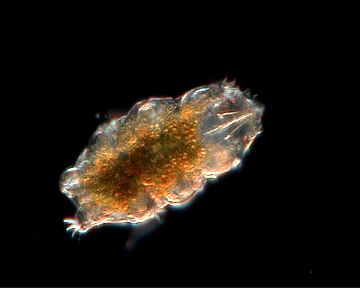Posted by
Dunia Sekitarmu
Tardigrades (known as Water Bear) is part of supefilum Ecdysozoa, phylum Tardigrada. The size is very small, live in water, with a total of eight feet. Tardigrades first described by Eprhaim Goeze in 1773.
Tardigrades name means "slow walker" given by Spallanzani (1777). Tardigrades adult body length is 1.5 mm, the smallest size is 0.1 mm, 0.05 mm-sized larvae.
Tardigrades can be found in all parts of the world, ranging from Himalayan peaks to the bottom of the ocean, and from the poles to the equator. On the beach, land and water can be found in this mini beast.
The most interesting of these animals is the ability to adapt in a very extreme environment.
Tardigrades can survive in an environment of frozen (0
° C) up in a high temperature (151
o c).
Even to withstand radiation 1,000 times higher than the amount of radiation in which other living things can survive.
Therefore, tardigrades known as polyextremeophiles animals.
With these capabilities, tardigrades are living creatures that can survive in the event of nuclear war or another natural disaster is extreme
. Even tardigrades can live for 120 years in dry conditions.
Another unique capability of tardigrades are able to survive in conditions of space vacuum.
In a study for 10 days tardigrades can live in outer space environment.
Tardigrades that was brought ino outer space using FOTON-M3 spacecraft by the European Space Agency, can survive in the vacuum exposed to cosmic rays, and can even survive the sun's UV radiation 1,000 times higher than the radiation at the earth's surface.
Sumber : Source:
eksplorasi-dunia.blogspot.com
apakabardunia






Post a Comment